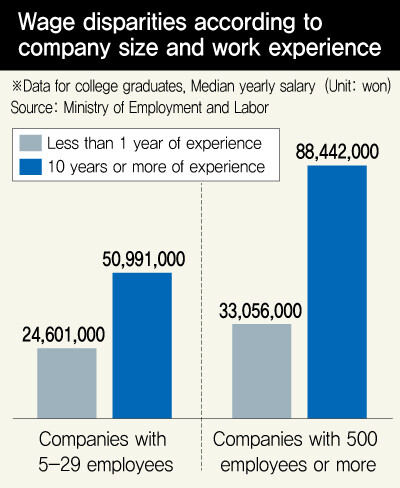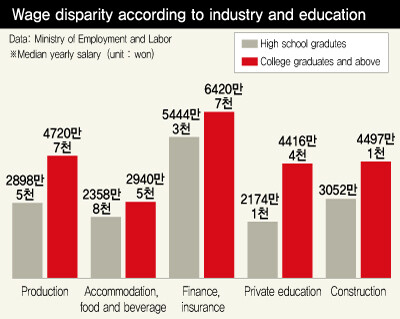hankyoreh
Links to other country sites 다른 나라 사이트 링크
Work disparity according to company size increases with work experience

The entry-level salary for university graduates at small companies is just 74.4% of that at large ones, a gap that widens (57.7%) for employees with 10 years of experience, government statistics show. While company size is the factor with the biggest impact on wages, the seniority-based pay system — under which employees’ wages rise the longer they work at a company — has the effect of gradually aggravating the pay gap.
On Feb. 18, South Korea’s Ministry of Employment and Labor released for the first time income distribution data categorized by company type. This data was produced through a cross-tabulation analysis of wages in terms of six variables; namely, company size, industry, job, experience, gender, and educational background. The data in question was derived from the wage structure section of the 2016-2018 surveys on labor conditions by employment type, converted to annual wages for 2019. The sample consisted of the wages (not including overtime or holiday pay) of 2.3 million full-time regular workers at companies with at least five employees.

This data set is designed to make it easy to review the wages of workers doing similar work in the same industry or in companies of the same size. The government has made the set available for anyone to view online via its wage and occupation information system (www.wage.go.kr).
This analysis was prepared by Oh Gye-taek, head of the wage and job innovation center at the Korea Labor Institute. “The factor that has the biggest impact on the wage gap is the size of companies,” Oh said.
For college graduates who have been working for less than a year, wages at companies with between five and 29 employees (24.6 million won, or US$20,660; this and all subsequent figures represent the median) were 74.4% of the level at companies with at least 500 employees (33.06 million won, or US$27,765). For college graduates with at least 10 years of work experience, wages at smaller companies (50.99 million won, or US$42,823) was just 57.7% of those at large companies (88.44 million won, or US$74,265).

Company size was observed to have a greater impact for employees with a lower educational background. For high school graduates and below who had been working for less than one year, there was no difference in wages at small companies (21.02 million won, or US$17,652) and at large companies (21.21 million won, US$17,813). But for those with at least 10 years of work experience, wages at small companies (32.63 million won, or US$27,406) stood at just 51% of those at large companies (63.9 million won, or US$53,671). While wages at large companies tripled over three years, wages at small companies only rose by 60%.
The gap in wages between men and women also varied with the size of the company. The wages of women working for less than a year at small companies (20.66 million won, or US$17,343) only stood at 85.2% of men’s entry-level wages (24.24 million won, or US$20,348), somewhat higher than the 74.5% figure at large companies (23.41 million won, or US$19,652, for entry-level women and 31.4 million won, or US$26,359, for entry-level men). But the reverse was true of workers with 10 years of experience, with wages for women at small companies (31.76 million won, or US$26,661) only 72.5% of what men were making (43.79 million won, or US$36,760) under the same conditions. At large companies, in contrast, the gap between women (62.66 million won, or US$52,601) and men (79.69 million won, or US$66,889) had narrowed somewhat, to 78.6%.
Hope for wages to be organized around job type, not seniorityThe publication of these wage distribution figures was one of the measures aimed at bringing about a fairer economy that were announced following deliberations between the government and the ruling Democratic Party in September 2019. The idea is that releasing these figures will encourage companies to mitigate the income gap on their own and reorganize the wage system around job type, rather than seniority.
“The information requested by companies’ HR staff was how much wages are being paid at similar companies. Our work is to provide some rough data that can provide guidance to companies that are reorganizing their wage regimes,” said Kim Min-seok, an official responsible for labor-management cooperation policy at the Ministry of Employment and Labor.
“Making wage information transparent is the first step toward paying the same wages for the same labor value, which will alleviate polarization and disparity in the labor market. I hope that publishing the current status of wage distribution will serve as an opportunity to move in a fairer direction and to launch a discussion about the origin and the extent of this problem,” said Noh Gwang-pyo, director of the Korea Labor and Society Institute.
“It would be even be better to involve labor and management in selecting, assessing, and verifying the statistics, however,” Noh added.
By Cho Hye-jeong, staff reporter
Please direct comments or questions to [english@hani.co.kr]

Editorial・opinion
![[Column] When ‘fairness’ means hate and violence [Column] When ‘fairness’ means hate and violence](https://flexible.img.hani.co.kr/flexible/normal/500/300/imgdb/original/2024/0516/7417158465908824.jpg) [Column] When ‘fairness’ means hate and violence
[Column] When ‘fairness’ means hate and violence![[Editorial] Yoon must stop abusing authority to shield himself from investigation [Editorial] Yoon must stop abusing authority to shield himself from investigation](https://flexible.img.hani.co.kr/flexible/normal/500/300/imgdb/original/2024/0516/4417158464854198.jpg) [Editorial] Yoon must stop abusing authority to shield himself from investigation
[Editorial] Yoon must stop abusing authority to shield himself from investigation- [Column] US troop withdrawal from Korea could be the Acheson Line all over
- [Column] How to win back readers who’ve turned to YouTube for news
- [Column] Welcome to the president’s pity party
- [Editorial] Korea must respond firmly to Japan’s attempt to usurp Line
- [Editorial] Transfers of prosecutors investigating Korea’s first lady send chilling message
- [Column] Will Seoul’s ties with Moscow really recover on their own?
- [Column] Samsung’s ‘lost decade’ and Lee Jae-yong’s mismatched chopsticks
- [Correspondent’s column] The real reason the US is worried about Chinese ‘overcapacity’
Most viewed articles
- 1China calls US tariffs ‘madness,’ warns of full-on trade conflict
- 2[Column] US troop withdrawal from Korea could be the Acheson Line all over
- 3[Editorial] Yoon must stop abusing authority to shield himself from investigation
- 4[Column] When ‘fairness’ means hate and violence
- 5[Column] How to win back readers who’ve turned to YouTube for news
- 6US has always pulled troops from Korea unilaterally — is Yoon prepared for it to happen again?
- 7[Book review] Who said Asians can’t make some good trouble?
- 8Naver’s union calls for action from government over possible Japanese buyout of Line
- 9Could Korea’s Naver lose control of Line to Japan?
- 10[Editorial] Korea must respond firmly to Japan’s attempt to usurp Line